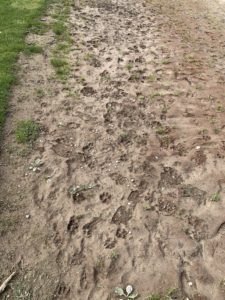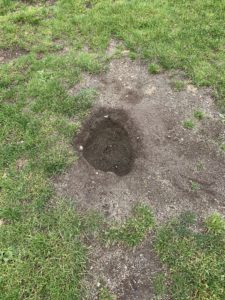By Kevin Mack, SAS Animal Control Officer and naturalist.
In addition to requiring that dogs and other pets be on leash and under control while in Seattle parks, the city’s municipal code identifies several areas in which pets are simply not allowed. These areas include any public beach, swimming or wading area, pond, fountain, stream, organized athletics area or designated children’s play area. But why have these specific areas been singled out as pet “no go” zones? There are many good answers to that question, some of which are more readily apparent than others.
Pets Cause Damage
The first reason that pets are not allowed in certain areas is that they cause damage. On playfields, the clawed feet of dogs literally tear up the ground as they run. Over time, yellowed, torn up “runways” develop in grassy areas where balls are repeatedly thrown for dogs to retrieve. Below is a photo of one such runway next to Miller Community Center in Seattle.
This damage can lead to the area becoming a muddy mess as more and more of the grass dies off. Artificial turf can also be damaged by the constant wear and tear caused by the claws of running dogs and this can significantly decrease the useful life of that turf and lead to the need for costly replacement.
Even areas on playfields that are supposed to be devoid of grass, such as the infield of a baseball diamond, may be damaged and turned into a mud pit by the constant patter of dog paws as can be seen in this recent photo taken at Soundview Playfield.
While dogs running on playfields can cause damage over time, some dogs damage fields very quickly by digging. Some of the holes dogs dig can be quite large making significant patches of a playfield unusable. Here are two such examples from Wallingford Playfield and Cascade Playground.
Other holes dug by dogs are smaller and harder to spot, especially if someone is running on the field playing soccer, ultimate frisbee, or another fast-moving sport. These less obtrusive holes, such as the one at Alki Playfield in the photograph below, may pose a significant tripping hazard.
Dogs, cats, and other pets may also damage playground equipment by chewing on it or scratching it. They may also urinate on it which brings us to a second reason pets are not allowed in some of these areas.
Pet Waste May Create A Sanitation Hazard
I will spare you the photos that graphically illustrate this concept and just offer a single image for your consideration. The following photo was taken on Alki Beach in Seattle.
As you can see in the photo it was a nice day and people were walking barefoot in the sand. On this same day I saw many children sitting in the sand digging, playing, and otherwise enjoying their day at the beach. In the photo you can also see that a dog had been walking on the sandy beach. The problem is, tracks are not the only thing that dogs and other pets leave behind.
Whether in the sand on the beach, grass on a playfield, or woodchips in a play area, even if a pet owner is very diligent about cleaning up after their pet they will invariably leave behind some fecal matter even if they scoop. And if the pet urinates, there is really no effective way to clean that up, nor is there a good way to remove it from a stream, pond, or fountain. Nobody wants to step in animal waste or have their child digging in or playing in areas contaminated by it.
Not only is it gross, pet waste may also harbor parasites and bacteria that could impact human health or the health of other animals. This brings us to a third reason why some areas- specifically beaches, ponds, and streams, are off limits to pets.
Pets Impact Wildlife
Seattle Parks contain the best available wildlife habitat in the city. They also contain some of the only undeveloped (or lightly developed) land/water interfaces available to Seattle’s wildlife. Wildlife tends to be more heavily concentrated in these areas as they are rich in resources these animals need to survive. More wild animals means a higher chance of interaction between these animals and your pet, interactions that may be detrimental to the health and well-being of both. Signs are posted at most areas with saltwater access alerting people that they need to stay away from federally protected species such as seals and sea lions, and these are often paired with signs reminding people that dogs are not allowed such as in this photo taken at Alki Beach Park.
But whether signs are present or not, if it is a pond, stream, or beach in a Seattle Park, always remember pets are not allowed.
Those are but a few reasons pets are not allowed at any public beach, swimming or wading area, pond, fountain, stream, organized athletics area or designated children’s play area in Seattle. The exact bit of Seattle Municipal Code that established these restrictions is SMC 18.12.080. The penalty for violating SMC 18.12.080 is an infraction level citation with a fine of $54 for the 1st offense, $109 for a 2nd offense, $136 for a 3rd offense, and $162 for each offense thereafter. So not only are there many good reasons for the rule, there is also very good reason to obey it.
That being said, there are still plenty of great places to enjoy some outdoor time with your dog or other pets in Seattle. The prohibited areas mentioned in this article only comprise a tiny fraction of the overall space available, and those areas aside, you can legally walk your pets in public parks, greenspaces and other public areas all over the city as long as they remain on leash and under your control. There are more than a dozen designated sites where you can legally let your dog get some off-leash time. A map and descriptions of Seattle’s off-leash dog parks can be found on the Seattle Parks and Recreation website here: http://www.seattle.gov/parks/find/dog-off-leash-areas
Please feel free to contact the Seattle Animal Shelter if you have any questions or concerns. To report parks violations, please use the City of Seattle’s online Customer Service Request system. We will be happy to help.







